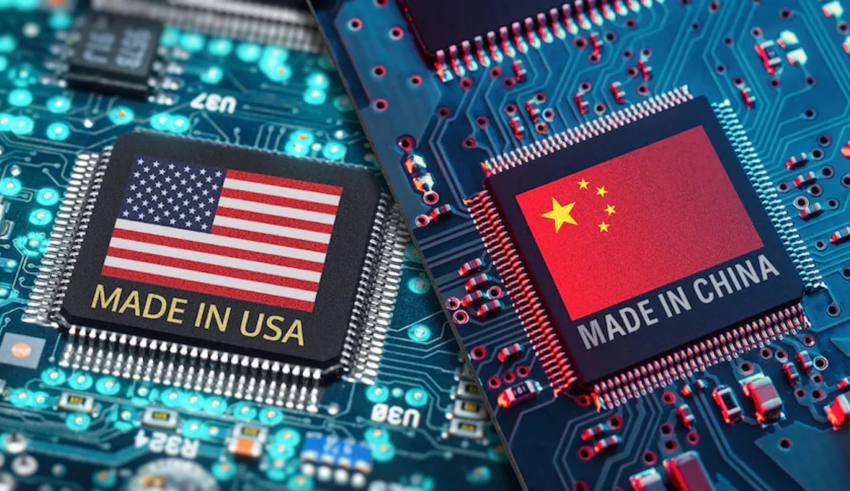
The US and China are currently engaged in a global struggle for dominance in the semiconductor industry, which has become a vital sector for everything from smartphones to advanced military technology.
China has made it a long-term economic development policy goal to strengthen its position in strategic technologies, including semiconductors, also known as `chips`. However, the US sees China’s technological advancement as a threat to its global power and national security and has taken steps to limit China’s access to advanced chip technology.
The US-China trade war has been ongoing since 2018, when the US issued the first sweeping restrictions on the export of chip technology. These restrictions have cut off Chinese companies’ access to crucial technology and impacted their ability to compete in the global market.
The US has since been implementing further trade restrictions, the latest being imposed in April of this year, in an effort to curb China’s progress in the semiconductor industry. Additionally, the US is investing heavily in its own chip industry, with the recent update to the U.S. CHIPS Act discouraging international high-tech investment in China.
The US has also been working to build a coalition of allies to join its efforts against China. In March 2023, following political pressure from the United States, the Dutch government announced export restrictions on “advanced” semiconductor manufacturing equipment, a major development in the U.S-China chip war since it will affect Europe’s largest advanced chip manufacturing technology producer, ASML, exports to China. Similarly, after some diplomatic efforts from the American side, the Japanese Foreign Minister confirmed that the country will go ahead with plans to put restrictions on some computer chip-making exports.
In response, China has also imposed restrictions on US tech companies. The country has restricted exports of certain types of advanced computer chips for AI applications and the diverse set of technologies needed to design them. Moreover, the Chinese government has limited access to key technologies, such as equipment needed to manufacture advanced semiconductors, for US companies.
China’s ability to retaliate is, however, limited, as American companies dominate the market for logic chips that are required to process data, and as American international pressure grows.
As part of its efforts to reduce its dependence on US technology, the country has been taking steps to develop its own semiconductor industry. This allowed increased competition in the industry, with Chinese companies such as Huawei and SMIC emerging as major players in the chip market. The trade war has also prompted other countries, such as India, to position themselves as alternatives to China’s chips.
The `war` has had a significant impact on the global tech industry, particularly in terms of innovation and disruptions in the global supply chain. The US, besides imposing restrictions on the export of chip technology to China, has also expanded restrictions on third-country production for Chinese customers of chips made with the same technology. These restrictions have led to disruptions in the supply chain, affecting both Chinese and non-Chinese companies that rely on these chips for their products. For example, Apple’s supply chain has been affected by China’s subsidies and America’s chip choke, forcing the company to make changes downstream. As a result, the global tech industry is facing significant challenges in maintaining its supply chain and meeting consumer demand for products.
The US-China war chip is a result of the geopolitical power struggle between the two countries. The battle over microchips has emerged as a proxy for geopolitical competition, with the US seeking to maintain its position as the dominant global power and China seeking to challenge that position. The future of the chip war remains uncertain, but it is clear that it has far-reaching implications for the global technology industry.
References
- China’s chip industry will be ‘reborn’ under U.S. sanctions, …. (n.d.) Retrieved May 16, 2023, from www.cnbc.com
- US-China chip war puts global enterprises in the crosshairs. (n.d.) Retrieved May 16, 2023, from www.computerworld.com
- Biden Administration Clamps Down on China’s Access to …. (n.d.) Retrieved May 16, 2023, from www.nytimes.com
- China’s New Strategy for Waging the Microchip Tech War. (n.d.) Retrieved May 16, 2023, from www.csis.org
- Fallout of US-China chip war could be global overcapacity …. (n.d.) Retrieved May 16, 2023, from www.scmp.com
- China struggles to retaliate against U.S. chip controls. (n.d.) Retrieved May 16, 2023, from fortune.com
- US-China chip war: Japan plans to restrict some …. (n.d.) Retrieved May 16, 2023, from www.bbc.com/news/business-65134017
- US chip controls threaten China’s technology ambitions. (n.d.) Retrieved May 16, 2023, from apnews.com
- United States–China semiconductor standoff: A supply …. (n.d.) Retrieved May 16, 2023, from www.atlanticcouncil.org
- The Chip War: US Restrictions, China’s Ambitions and …. (n.d.) Retrieved May 16, 2023, from www.c3sindia.org
By The European Institute for International Law and International Relations.















